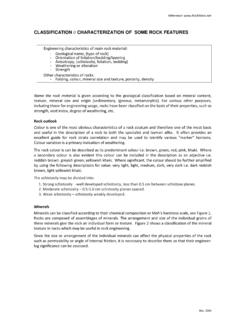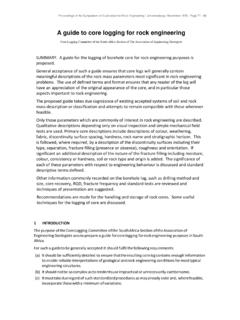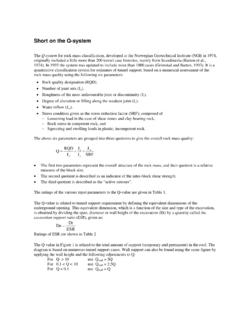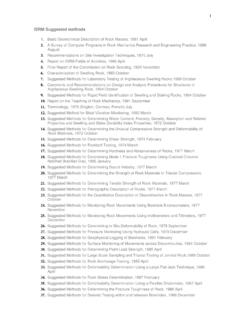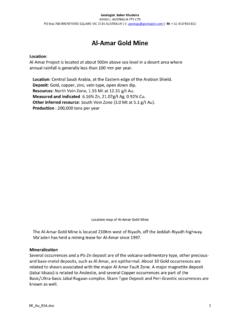Transcription of Joint characteristics - RockMass
1 January 2015 Reference: A. Palmstr m, Joint characteristics Introduction There is a difficulty in giving a concise definition of what constitutes a Joint . Over the years there have been several discussions whether ' Joint ', 'fracture' or other terms should be preferred in rock mechanics, engineering geology and rock engineering. ISRM (1975) has chosen ' Joint ' defined as: " Joint is a discontinuity plane of natural origin along which there has been no visible displacement." There is a great variety of joints, from small cracks to long shears or seams, as seen in Figure 1.
2 Figure 1: .The size span of different types of discontinuities (revised from Palmstr m, 1995) The terms for the various types of joints in Figure 1 are generally chosen from their size and composition. Some supplementary definitions of these and some others are given as follows: Crack is a small, partial or incomplete discontinuity. (ISRM, 1975) Fracture is a discontinuity in rock due to intense folding or faulting. (Dictionary of geological terms, 1962). Fracture is a general term used in geology for all kinds of discontinuities caused by mechanical stresses in the bedrock.
3 Fractures include joints and cracks and faults. It is suggested not to use this term in rock engineering and engineering geology. Parting is a plane or surface along which a rock is readily separated or is naturally divided into layers, bedding-plane parting. (Glossary of geology, 1980).1 Rupture is a fracture or discontinuity caused by excavation works or other human activities. Seam 1) a minor, often clay-filled zone with a thickness of a few centimetres. When occurring as weak clay zone in a sedimentary sequence, a seam can be considerably thicker.
4 Otherwise, seams may represent very minor faults or altered zones along joints, dikes, beds or foliation. (Brekke and Howard, 1972). 2) a plane in a coal bed at which the different layers of coal are easily separated. (Dictionary of geological terms, 1962) 1 Partings which often occur as bedding plane and foliation partings, are separations parallel to a mineralogically defined structural weakness in the rock. They are most often tight and rough except where flaky minerals (mica, chlorite ) occur.
5 2 January 2015 Reference: A. Palmstr m, Shear is a seam of sheared and crushed rock usually spaced more widely than joints and is marked by several millimetres to as much as a metre thickness of soft or friable rock or soil. Singularity is used as a general term for seams, filled joints, shears or other persistent discontinuities which are not considered as belonging to the general or detailed jointing. The main Joint characteristics are indicated in the Figure 2. Figure 2: Main characteristics of a Joint . Also orientation is an important characteristic A Joint is a three-dimensional discontinuity composed of two matching surfaces called Joint walls.
6 It is composed of several characteristics of which the main are, see Figure : A. Length (size) and continuity of the Joint B. Separation C. Joint surface characteristics (smoothness and waviness) D. Condition (alteration) of the discontinuity, whether the wall is fresh or weathered/altered and/or presence of possible filling. There are two main groups of discontinuities: Firstly feature characteristics of the origin of the rock such as bedding, foliations and flow bands, and secondly features occurring as a result of tectonic rupture (fractures) such as joints, fractures, faults and shears.
7 A. Joint size and continuity Discontinuities constitute a tremendous range, from structures of up to several kilometres in extent down to a few centimetres, see Figure 1. Discontinuous joints terminate in massive rock. Such joints can be foliation partings, en echelon joints in addition to many of the smaller joints (less than 1 metre long). Continuous joints terminate at other joints. Table 1: Classification of Joint size (based on Bieniawski, 1984) SIZE Joint LENGTH Very short Short Medium long Very long < 1 m 1 - 3 m 3 - 10 m > 10 m Very long joints and seams or shears occur often as singularities (see Figure 1).
8 3 January 2015 Reference: A. Palmstr m, The size of a Joint may vary within the same Joint set. This is specially the case for foliation joints where small joints or partings often occur between longer, continuous joints. The length (size) can be crudely quantified by observing the Joint trace lengths on the surface exposures. Often, rock exposures are small compared to the area or length of persistent joints, and in such cases the real persistence can only be guessed. B. Separation Separation is the maximum distance between two Joint walls.
9 It is generally small, mainly less than a millimetre, except for filled joints, seams or shears. The size of the Joint is often proportional to the thickness or separation of the Joint . Aperture is the perpendicular distance separating the adjacent rock walls of an open discontinuity, in which the intervening space is air or water filled. Aperture is thereby distinguished from the width of a filled discontinuity (ISRM, 1978).) Table 2: Classification of the separation of joints (from Bieniawski 1984) TERM SEPARATION Very tight Tight Moderately open Open Very open < mm - mm - mm - 10 mm 10 - 25 mm C.
10 Description of the Joint surfaces Waviness Large, low angle asperities that cannot be sheared off are termed waviness, see Figure 3. They cannot be reliably measured in a drill core. Figure 3: The Joint wall features can be characterised by the large scale waviness (top) and the small scale smoothness (or unevenness) (from Palmstr m, 1995). Ideally, the Joint waviness should be measured as the ratio between max. amplitude and Joint length. As it is seldom possible to observe the whole Joint plane, a simplified measurement is normally carried out the so-called undulation factor, representing the ratio between max.
